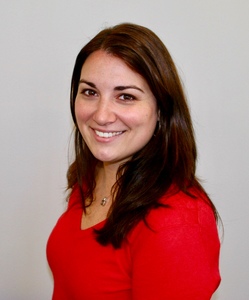Standing Out in a Sea of Content: Northwell Health’s Success Rests on a Hyper-Focused Content Strategy
// By Melanie Graham //
 For many years, the marketing and communications team at Northwell Health knew it wanted to build out its consumer content experience. As one of the biggest health systems in the country and the largest private employer in New York state, Northwell needed to show that it was on the pulse of what was happening in healthcare and that it was willing to connect with patients in a meaningful way.
For many years, the marketing and communications team at Northwell Health knew it wanted to build out its consumer content experience. As one of the biggest health systems in the country and the largest private employer in New York state, Northwell needed to show that it was on the pulse of what was happening in healthcare and that it was willing to connect with patients in a meaningful way.

Gina Czark, vice president, content management at Northwell Health
“We wanted to put content out there that was relevant in people’s lives, and not just content about our services and awards,” says Gina Czark, vice president, content management at Northwell. “It couldn’t be building a corporate newsroom or an obvious marketing website, but rather sharing true stories of healthcare and the people going through milestone healthcare events.”
With this content mission, Czark and the Northwell team launched The Well in early 2018, and although it’s still in its early stages, the site has already seen success.
After a soft launch in January and subsequent public relations push, the team began promoting The Well content in late February. As of July 2018, The Well had garnered nearly 1 million page views and 350,000 unique visitors.
In addition to the growing reader numbers, content on The Well also frequently turns up in the top-10 most visited pages for all Northwell.edu.
“We’re tracking stats every week and it’s constantly increasing,” Czark says, “and it’s broken through as some of the most highly trafficked pages on Northwell’s website.”
A Hyper-Focused Content Strategy
The Well’s content strategy is not one that mimics most health organization blogs or consumer sites. It doesn’t focus on generic symptom explanations or health library-style articles, Czark says. Instead, the site homes in on “moments of truth in someone’s life.”
“A healthcare experience is one of the most emotional moments you’re going to have in your life,” Czark says. “The content strategy for The Well is about storytelling and engagement, so we can put the emotion back into healthcare and not lose sight of that.”
With that in mind, Northwell’s content team looks at important milestones in both the everyday life and each decade of someone’s life, and crafts articles specifically for those moments and milestones. For example, the team may write an article for a 40-year-old woman prepping for her first mammogram or create a list of tips for what a parent can expect when bringing his/her daughter to her first OB/GYN exam.
In addition, the team also commissions original journalism and first-person essays that focus on life’s unexpected challenges (like the relationship a daughter has with her father in hospice care) and social issues like the opioid crisis.
“We’ve shifted away from writing for the generic reader to specific audiences,” Czark says. “Everything we write has a specific person in mind.”
That hyper-focus on readers carries over into Northwell’s social promotion strategy. The team’s most successful channel — paid Facebook ads — is “extremely targeted,” so the content is served up to a core audience that is interested and engaged.
Northwell makes sure to promote its content on cost-per-click/pay-per-click (CPC/PPC) networks, but because of its ability to target so well, Facebook remains the frontrunner for traffic and engagement. In fact, Northwell’s average CPC on Facebook is at about $0.25 — well below the industry average of $1.32 (WordStream, 2017) — and its click-through-rate (CTR) sits at about 6.6 percent (WordStream lists the 2017 healthcare industry CTR average at 0.83 percent).
“One of the interesting aspects of our paid content on Facebook is that the comments and engagement we see are all germane to the topic of the article,” says Czark. “People enjoy the content and tell us that the article is great or helpful.”
Czark says her team also has a “robust” A/B testing strategy that is crucial to The Well’s continued success — they test and continuously optimize copy, creative, and ad types.
Personal Stories That Resonate
In addition to hyper-focused content strategy, Northwell also pays close attention to healthcare issues trending in the news cycle, as well as seasonal topics such as summer sun safety.
Czark’s in-house digital marketing team also puts together analysis on heavily searched words or topics, which helps inform headlines and content decisions.
Each article on The Well fits into one of the site’s nine sections uniquely named to connect more with the reader (“Asking for a Friend,” for example, addresses topics that some may be embarrassed to ask about).
Of the many types of content on The Well, stories that feature patients and firsthand accounts from physicians tend to rise to the top.
“The personal stories really resonate with people,” Czark says.
The clinician articles, especially, have seen tremendous success. The articles, which are ghostwritten by Czark’s content staff and freelance writers, feature a modern physician advice column, personal stories about their own significant healthcare events (such as an orthopedic surgeon who undergoes a hip replacement), or a glimpse at a “day in the life” of a doctor.
One of The Well’s most successful articles featured a day in the life of one of Northwell’s neurosurgeons, a piece that received overwhelming positive feedback and numerous shares on social media — including a tweet from a New York Times reporter.
Very moving essay by brain surgeon David Langer. The Most Important Five Minutes of Brain Surgery https://t.co/nz0C0SZTMK
— Denise Grady (@nytDeniseGrady) January 26, 2018
“The physicians have been on board because they see it is as fresh and relevant content,” Czark says. “Plus, they love that they can get into the human aspects of healthcare.”
Measuring Success
As many healthcare marketers know, a good content strategy and strong data tracking go hand in hand. At Northwell, the content team has a robust dashboard that it regularly updates, tracking everything from page views to return visitors, demographics to geolocation, scroll rates to video completion rates.
“We track everything throughout the entire digital ecosystem to see where we’re making the most impact,” Czark says.
In addition to tracking actions on social media and The Well, Czark says her team also pays close attention to how new users interact and move around the entire Northwell website. They look at patterns of new users, where they click, and what type of content they consume on both The Well and Northwell.edu.
The content team has also partnered closely with the consumer insights and analytics team, led by Vice President Joseph Fierro, to build out robust, back-end marketing automation that customizes content for readers on The Well.
“We’ve implemented artificial intelligence in the background of The Well to analyze demographics, behavior, attitudinal schema, and consumption patterns to serve up the most relevant content,” Fierro says. “Through data analysis and applying AI, we will be able to scale these interactions in real time. This is the future of content marketing.”
With this tool in place, consumers may see different articles based on what they’ve previously viewed on the website or topics where they’ve shown interest, creating a more “personalized experience,” Fierro says.
Looking Ahead
As of this writing, The Well had just over six months under its belt, and the team at Northwell has made huge strides in growing an engaged following. But its work is far from over. Looking ahead to the rest of 2018 and beyond, Czark says they will continue to dive deep into the content and topics their audience is looking for, and to optimize stories that fit readers’ needs, worries, and questions.
The team also recently launched its first e-newsletter and saw an open rate of nearly 34 percent — well above the industry average of 21 percent (according to MailChimp email marketing benchmarks). Additional email marketing efforts are also on the team’s radar, as well as enhancing content personalization for readers.
“We’re going to continue working to build that ideal, engaged audience,” Czark says.
Reflecting on The Well’s early success, Czark says it’s been important for her and her team to “remain strong in their editorial convictions.” In other words, the team needs to have a clear vision of the site’s editorial strategy and what kind of content belongs on it. If it doesn’t fit, they have to feel confident in saying it should live on another Northwell channel.
“We looked at this as an opportunity to think outside the box, to let data drive our decisions and determine what stories weren’t being told and what we as healthcare leaders should be steering the conversation toward,” Czark says. “If you’re willing to be bold and innovative, and you take risks, you’re on your way to success.”
Melanie Graham is a writer, editor, and digital strategist specializing in nonprofit and healthcare communications. She has a background in journalism, with experience in digital content marketing and social media management.

